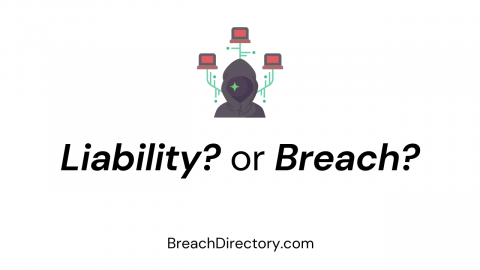This blog has been updated and may be updated in the future.
These days, data breaches are a frequent friend of web applications – however, there are so many terms related to them… As no one data breach is exactly the same and the details of these things are often so hard to find out, it’s sometimes hard to distinguish a data breach from a data leak.
In this space, two terms that are often confused are cyber liability and a data breach – what’s the difference between them? Are they different at all? That’s what we’re answering in this blog.
What Is a Data Breach?
First things first, a data breach is an incident where sensitive information is exposed to an unauthorized body. In many cases, a data breach is the direct result of an attack on a web application such as SQL injection, Cross-site Scripting, Cross-site Request Forgery, etc., but in some cases, data breaches can occur due to social engineering too.
The consequences of a data breach vary from company to company and they’re directly dependent on the data classes that are exposed. The consequences of a data breach that exposes only usernames or email addresses may not be as severe as the consequences of a data breach that exposes emails, usernames, IP addresses, passwords, credit card details, and physical addresses – in many cases, though, stolen data is limited to email addresses, usernames, and passwords.
That’s not to say that data breaches don’t do damage, though – far from it: they’re making headlines. Part of those headlines is due to the financial damage that they do – part of it is due to cyber liability. Companies that don’t have cyber liability insurance often find themselves struggling to pay the price of a data breach.
What Is Cyber Liability?
Cyber liability is insurance from data breaches – in other words, insurance from cyber attacks. The main aim of cyber liability is to protect businesses from bleeding cash in case of a data breach – cyber liability insurance covers some or all of these aspects:
- Customer notification about a data breach.
- Recovering data.
- Legal fees and related expenses.
- In some cases, cyber liability includes the media and related third-party costs.
Most cyber insurance programs also sometimes require companies to notify their customers about a data breach. Depending on the program, it may also cover forensic expenses, and in some cases, even cover details about the negotiation and the payment of ransomware demands.
Minimizing Cyber Liability
In order to minimize cyber liability, you have to ensure that the application backing the product your company sells is as secure as possible. That may mean securing all of your code according to the standards set by OWASP, sanitizing every input field that you can imagine, using a web application firewall, or using data breach search engines and their API capabilities such as the one provided by BreachDirectory.
The data breach search engine and the BreachDirectory API both serve a distinct purpose – the data breach search engine allows everyone to assess their likelihood of being exposed in a data breach, and the BreachDirectory API allows companies, universities, individuals, and law enforcement agencies to implement the backbone – the data existing in the BreachDirectory search engine – into their own projects. Here’s what the documentation of the API looks like:

As of the time of writing, the BreachDirectory API has a couple of distinct plans – a Personal Plan, a Simple Plan, a Bulk Plan, and a Reseller Plan. The Personal Plan is a fit for individuals that are interested in cyber security and want to implement the data behind the data breach search engine into their own projects, the Simple Plan is a fit for those who want to implement the API into more systems and query it more often, the Bulk Plan is a fit for companies and enterprises that want to secure a lot of accounts at once, and the reseller plan is a fit for those who want to make some money.
Before acquiring API keys from BreachDirectory, many users use the data breach search engine to assess their likelihood of being exposed in a data breach and the need to protect their own employees if they manage a team.
The BreachDirectory API is used for a variety of purposes, the main ones being related to open-source intelligence (OSINT) capabilities. Curious how it all would work on your infrastructure? Give it a try today and find out!
